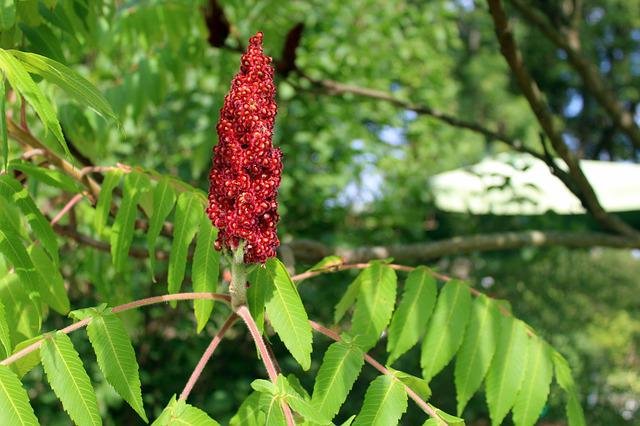
Sumac is the name of a genus of plants that includes small trees and shrubs used for ornamental purposes. They are also appreciated for their multiple phytotherapeutic properties. In fact, a well-known homeopathic remedy is obtained, a varnish and a spice. Some species are toxic. Let’s see them in detail.
Sumac – what is it?
The most evident feature are its branches, covered with a thick down. The greenish-white or yellow-green inflorescences are united in panicles. The leaves are rich in tannin and turpentine, while the fruits give rise to one of the most used spices in the Middle East.
In the United States there are Rhus glabra and Rhus aromatica, used only for ornamental purposes, including various toxic species, while in Italy Rhus coriaria is indigenous.
Rhus coriaria
The coriaria subgenus is found mainly in southern Europe and the Middle East. It is a deciduous shrub that can reach up to 3 meters in height. In Italy it can be found starting from 800-1000 meters. above sea level.
Its leaves have an elongated shape and even reach 20 cm in length. It blooms between May and August. Its fruits, fleshy, juicy and fibrous, are red-brown and poisonous if eaten fresh and raw.
Sumac plant
Sumac or sumac is a shrub of the Anacardiaceae family. Being càduco, it changes the color of the leaves with the passing of the seasons.
Sicilian sumac plant
The other name of the Rhus coriaria is Sicilian sumac. In this region it is in fact present in greater quantities, in particular in the area of Palermo and Trapani.
Wild sumac
The greater sumac, or Rhus typhina, is the American sumac, but it is also found throughout the northern part of Italy, where it also occurs as a wild shrub.
Greater sumac
Introduced to Europe in the 17th century as an ornamental plant, this variety is often grown in parks and gardens.
Also known by the names of rus hairy or ruso (Veneto), bruschin (Emilia-Romagna) and scotano (Tuscany), it is a potentially poisonous plant (the fruits and the latex).
All its parts, except the roots, can be used as a dye and stain for wood. The leaves, in particular, are in fact rich in tannins, useful for improving the resistance of the color to light. It blooms between May and June.
Sumac tree
It is found mainly in Italy, the USA and Asia. In the Karst there is the Rhus cotinus species, which colors the slopes of a beautiful flaming red.
It does not exceed 3 meters in height, but in sheltered areas it can even reach 10 meters. It is also known as the wax tree, fog tree, leather sumac and wig tree.
Sumac tree property
At one time, wood was also used by luthiers to make musical instruments and by turners and cabinetmakers for fine furniture, for inlays and for making pipes. But it is a plant also known in medicine and cooking. Other species, on the other hand, are poisonous, and can cause skin irritation.
It has diuretic, antibacterial and antipyretic, antifungal and anti-inflammatory properties. In addition to protecting the cardiovascular system, it is able to purify the blood of toxins and keep blood sugar levels under control.
It is also an anticancer, and is able to counteract the formation of atherosclerotic plaques and lower cholesterol. In addition to analgesic, astringent and anti-haemorrhagic virtues, it is capable of protecting the brain and stomach and regulating the intestine.
Therefore useful against dysentery, fever and hemorrhoids, it can also be used in case of anemia and as a tonic.
Is sumac poisonous?
It has several contraindications. If consumed in high doses, the sumac can cause: intoxication, delirium, dizziness, damage to the renal and gastrointestinal systems.
Sumac in the kitchen
The spice is obtained from the drying and grinding of the fruit. In Lebanon and Syria it is used to flavor fish. For Iraqis and Turks it is perfect in salads, and is the favorite condiment of Iranian and Georgian kebabs.
Also used to flavor bread and rice, it is one of the ingredients of fattoush. Combined with thyme and sesame, it gives life to zaatar, a blend used in North Africa, Turkey and Jordan to season meat.
Sumac spice
Its fruits are harvested in summer and smell of lemon, but their flavor is sour, spicy and pungent. Its anti-aging power is 73 times higher than that of apple, and is therefore the most powerful of all.
Once a natural remedy against gingivitis, menstrual pains, nosebleeds, coughs and intestinal disorders, today it is used to prepare an herbal tea that treats stomach aches and fever.
Sicilian sumac spice
In Sicily, however, leaves and bark were used by tanneries and dry cleaners to give the garments different shades of color: from black to blue-green and from red to yellow.
Sumac powder
The powder, added at the end of cooking, is sometimes replaced by the juice, obtained from the seeds soaked and then shredded. It can thus be used on chicken-based dishes, on lentils, onions and in yoghurt -based sauces.
Sumac spice recipes
This spice can be used as a decoction against gastrointestinal disorders and to flavor various dishes.
Sumac decoction
To make a decoction you will need:
- 15 gr of crushed and dried seeds
- 1 l of water
Procedure. Put the powder in a filter in water that you boil for 5 minutes, let it cool. Filter. Consume 2 cups a day.
Sumac and chicken soup
For this spiced chicken soup, you will need:
- 500 grams of fatty red meat
- 1 chicken of about 750 gr in pieces
- 1 chard
- 5-6 carrots
- 2-3 onions
- 2 leeks
- 3 eggplants
- breadcrumbs _
- 1 liter of vegetable broth
- dried coriander
- cumin
- black pepper
- ginger powder
- cinnamon
- 2-3 fresh mint leaves
- 8-10 walnut kernels
- 1 clove of garlic
- 1 egg
Preparation. Cut the chicken into large pieces of and put them in a pan with water. Boil, meanwhile remove the foam. Add the chard cut into 5 cm long pieces. Add the chopped carrots, sliced onions and sliced leeks. Blanch the aubergines, remove their skin. Add to the chicken. Once cooked, the meat and vegetables must be chopped in a food processor. In a bowl, add the egg and make medium-sized meatballs. Fry them in a pan with plenty of oil.
In a saucepan, boil the sumac with a little salt and the crumb. Pass through a sieve. In a saucepan, combine the meatballs, spices and mint, add the sumac. Mix the walnuts and garlic and add. Sprinkle with a little broth, and add as it dries during cooking. Over low heat, mix all the ingredients. Let it rest and serve the tipeida soup.
Sumac meaning
‘Sumac’ derives from the Arabic summāq, a 14th century word linked to summaqia, a well-known dish in Islamic culture. It is prepared to celebrate Nawruz, a celebration, similar to the New Year, which falls on March 21st.
In this period, the 7 ‘S’ are consumed, that is 7 dishes that begin with S and each represent an aspect of life. As the sumq, the sumac fruits that symbolize, for their flavor, the roughness.
The scientific name Rhus derives from the Celtic ‘ rhudd ‘, which means red; like the color of the fruit.
Sumac cultivation
It is a very rustic plant, which adapts to rocky and arid soils, but is also able to withstand frost down to – 20 °. Ideal for creating splashes of color in the garden.
Sicilian sumac cultivation
To make it grow quickly, prefer clayey, rich but well-drained soil. To be watered once a week. Fertilization, of organic type, should be reserved for autumn, or in spring for young plants. The soil must not be too rich in nitrogen as it will weaken it.
Pruning is not necessary; if you want to give shape to the branches, it will be necessary to intervene in February.The plant multiplies at the beginning of winter by dividing the root suckers. But it can also reproduce by cutting, from April in sandy soil, and from June by layering.
Sumac weed
Sumac can also be found wild and is considered a weed. In fact, it reproduces easily, through the seeds that are carried away with the wind.
To keep it under control, it is recommended to root out new plants immediately, not to use contaminated soil and to dispose of waste carefully.
Is sumac flammable?
It is able to resist fire, since it can sink its roots even in a few centimeters of earth and between the cracks in the rock. A few months after a fire, new shoots are already being generated from the branches.
Poison sumac
Also belonging to the Rhus genus there are some varieties such as Rhus Toxicodendron and Toxicondendron Miller which are toxic plants. In addition to these are also:
- Western poison oak (Toxicodendron diversilobum or Rhus diversiloba), a shrub typical of North America with leaves, divided into 3, which have earned it the name of climber’s nettle.
- Asian poison ivy (Eastern Toxicodendron or Eastern Rhus), widespread throughout Southeast Asia.
- Potanin lacquer tree or Chinese paint tree (Toxicodendron potaninii or Rhus potaninii), is found in central China, and has a resin used for the production of Japanese lacquer.
- Poison ivy (Toxicodendron radicans or Rhus radicans) or Canadian ivy, has a monosaccharide, rhamnose, on its leaves, which causes severe contact dermatitis.
- Western poison ivy (Toxicodendron rydbergii or Rhus rydbergii) is also native to the northern parts of the United States and Canada.
- Wax tree (Toxicodendron succedaneum or Rhus succedanea), native to Asia, is also present in Australia and New Zealand, where it is classified as a noxious weed. The fatty acids of its grains are used as biodiesel.
- Atlantic poison oak (Toxicodendron pubescens or Rhus toxicarium) grows mostly in sandy soils. It has small tufts of hair on the veins of the underside of the leaves.
- Lacquer tree or varnish tree (Toxicodendron Paintifluum or Rhus Paintiflua) grows especially in China and Japan. Its sap produces a lacquer rich in an allergenic oil, urushiol, which gives the Japanese name to the species (urushi). It is also called the Japanese lacquer tree, Japanese paint tree, and Japanese sumac.
- Poison sumac (Toxicodendron vernix or Rhus vernix) is another shrub or small tree typical of open and swampy areas. It also contains urushiol and is the most virulent species in the USA.
Is sumac poisonous to animals?
Deer and birds feed on poison ivy with no side effects. For dogs and cats, on the other hand, fruits and leaves are toxic.
Sumac sale

Recently, the scientific community has recognized the homeopathic properties of Rhus toxicodendron as an analgesic and anti-inflammatory with neuroprotective and antioxidant effects.
To avoid allergic reactions, the plant is grown before flowering. However, it is advisable to consult your doctor before using it.
Sumac pharmacy
Therefore, it is possible to find sumac in granules and in alcoholic extract for the treatment of joint, muscle, sprains, sprains and sciatica pains.
But it is also useful in case of flu, against sunburn, chicken pox, herpes; colds, conjunctivitis and dysmenorrhea. In the East, it is known as a remedy for rheumatism.
Sumac plant for sale
The plant can be found at nurseries. The most common are the coriaria, the aromatica, the radicans and the typhinia. The spice, on the other hand, can be found online and in herbalist stores.
On the market there are also mother tincture and dried bark.






